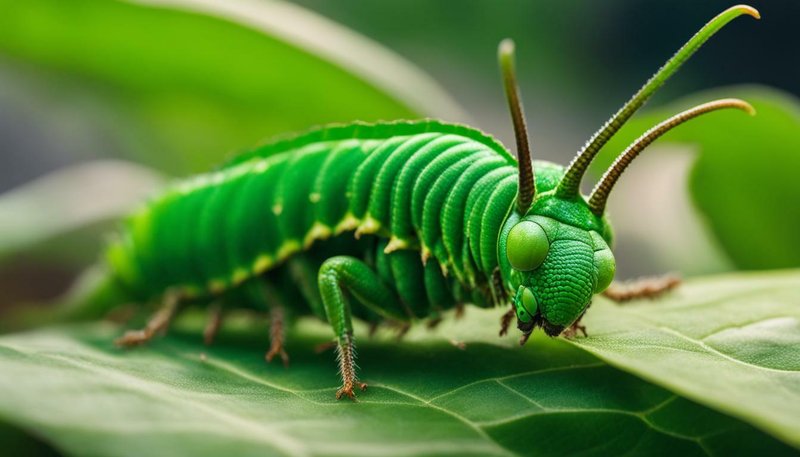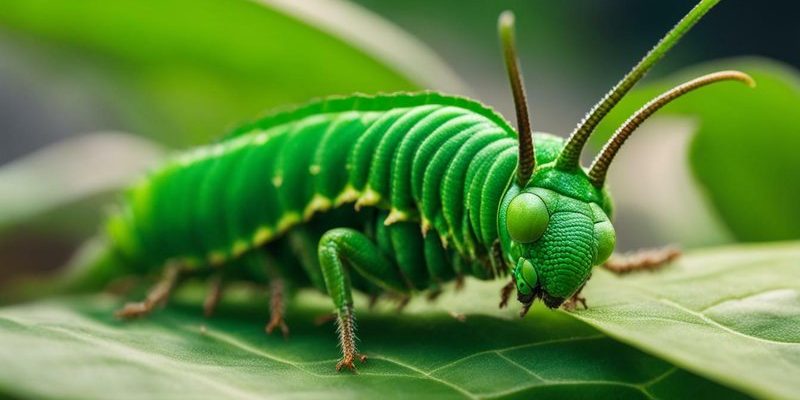
Many pet owners, especially those with lizards or other insectivores, rely on brands like *ReptoMin* or *Zoo Med* for their hornworms. But before you jump into feeding these wriggly treats, let’s take a moment to explore the best practices for safely handling hornworms. It’s a bit like learning how to handle a delicate flower; you want to appreciate its beauty without damaging it.
Understanding Hornworms
Hornworms, often found in shades of green with a distinctive horn on their tail, are the larvae of the Five-spotted Hawk Moth. They can grow quite large, some reaching up to 4 inches! They’re popular in the pet industry because they’re packed with protein, making them an excellent choice for reptiles like bearded dragons or chameleons. Plus, they’re soft-bodied, reducing the chance of your pet choking.
When introducing hornworms into your pet’s diet, it’s essential to understand their lifecycle and nutritional needs. They thrive in warm, humid environments and are usually sold in cups or containers with a gel substrate. This gel provides hydration and nutrients, which are crucial for their growth and health. Understanding how to care for your hornworms can mean the difference between a happy pet and a sick one.
Here’s a tip: Always check your hornworms before buying. Make sure they’re not too small or too large for your pet. If they’re too small, they won’t be filling enough, and if they’re too big, they might be intimidating for your pet to tackle. Ideally, the hornworm should be about the size of the space between your pet’s eyes.
Safe Handling Techniques
Handling hornworms requires a gentle touch. Think of them as the little delicacies of the insect world. You don’t want to damage them, or worse, let them escape! Here’s what you should keep in mind:
- Wash Your Hands: Start by washing your hands thoroughly. This keeps the hornworms safe from harmful bacteria that might be on your hands.
- Use Tweezers: If you’re a bit squeamish about touching them, a pair of tweezers can help. Pick them up gently by their body, avoiding the head or tail.
- Keep Them Secure: Always handle them in a confined space. This prevents them from wriggling away unexpectedly.
- Observe Their Behavior: If a hornworm seems sluggish or inactive, it might be a sign of stress or illness. In such cases, avoid handling them until you assess their health.
By following these simple steps, you can ensure that your hornworms are handled safely and with care.
Creating a Suitable Environment
Before you even bring hornworms home, ensure you have everything ready for them. An ideal environment can make a huge difference in their health and longevity.
Hornworms like warmth and humidity, so consider the following:
- Temperature: They thrive in temperatures between 75°F and 85°F. If your home is cooler, you might need to place them under a heat lamp or in a warmer room.
- Humidity: A humid environment helps them stay hydrated. You can mist their habitat lightly, but avoid soaking them.
- Feeding: Hornworms eat a special diet, often consisting of mulberry leaves or specially formulated diets like hornworm chow. Ensure they have fresh food.
By providing a suitable environment, you’ll keep your hornworms healthy and nutritious, making them a great treat for your pets.
Feeding Hornworms to Your Pets
Once you’ve got your hornworm setup right, it’s time to introduce them to your pets. But how should you go about it? Here are some straightforward tips to make feeding time a breeze:
- Introduce Gradually: If your pet is new to hornworms, offer just one at a time. This allows you to monitor their reaction and appetite.
- Watch for Preferences: Some pets may take to hornworms more naturally than others. If your pet seems hesitant, don’t be discouraged; it might just need more time.
- Monitor Portions: While hornworms are nutritious, they should only be a part of your pet’s diet. Too many can lead to obesity. Stick to a balanced diet!
Here’s a little story: A friend of mine had a bearded dragon who was pretty picky. He wouldn’t touch crickets, but once he tried hornworms, it was love at first sight! It’s all about finding what works for your pet.
Cleaning and Maintenance
Keeping your hornworm habitat clean is crucial for their well-being. A dirty environment can lead to bacterial growth and disease, harming both the worms and your pets. Here’s how to keep things tidy:
- Regular Cleaning: Clean out any uneaten food and waste daily. It doesn’t take long, and it keeps things fresh.
- Change the Gel: If you’re using a gel substrate, replace it every few days to prevent it from becoming contaminated.
- Check for Pests: Occasionally, check the container for any signs of mold or unwanted pests. A clean habitat is vital for healthy hornworms.
Cleaning might seem tedious, but it’s a small price to pay for ensuring your hornworms remain healthy and tasty for your pets.
Recognizing Signs of Stress or Illness
Like any living creature, hornworms can experience stress or illness. Recognizing these signs early can save them from serious health issues. Here are some red flags to watch out for:
- Color Changes: If your hornworm starts to look dull or loses its vibrant color, it might be stressed or unhealthy.
- Inactivity: While hornworms are not known for being speedy, excessive lethargy can indicate a problem.
- Body Condition: Keep an eye on their size and shape. If they seem to be shrinking or have unusual bumps, they might need immediate attention.
If you notice any of these signs, it’s best to consult with a vet who specializes in reptiles or exotic pets. Being proactive will help you ensure your hornworms stay healthy for your pets.
Handling hornworms may seem overwhelming at first, but with a little knowledge and care, it can become a rewarding part of your pet care routine. These nutritious snacks not only keep your pets happy but can also be a fun aspect of pet ownership.
Remember, the key to safe handling practices lies in your understanding and respect for these little creatures. By following the steps outlined above, you’ll ensure both your hornworms and pets thrive together. So the next time you see that little green worm, you’ll feel confident knowing exactly how to handle it. Safe practices lead to happy hornworms and even happier pets!

